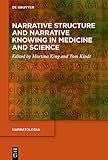Narrative Structure and Narrative Knowing in Medicine and Science / ed. by Martina King, Tom Kindt.
Material type: TextSeries: Narratologia : Contributions to Narrative Theory ; 90Publisher: Berlin ; Boston : De Gruyter, [2023]Copyright date: ©2024Description: 1 online resource (VIII, 206 p.)Content type:
TextSeries: Narratologia : Contributions to Narrative Theory ; 90Publisher: Berlin ; Boston : De Gruyter, [2023]Copyright date: ©2024Description: 1 online resource (VIII, 206 p.)Content type: - 9783111314310
- 9783111320175
- 9783111319971
- 650.01/9 23/eng/20240129
- online - DeGruyter
- Issued also in print.
| Item type | Current library | Call number | URL | Status | Notes | Barcode | |
|---|---|---|---|---|---|---|---|
 eBook
eBook
|
Biblioteca "Angelicum" Pont. Univ. S.Tommaso d'Aquino Nuvola online | online - DeGruyter (Browse shelf(Opens below)) | Online access | Not for loan (Accesso limitato) | Accesso per gli utenti autorizzati / Access for authorized users | (dgr)9783111319971 |
Frontmatter -- Acknowledgements -- Contents -- Introduction -- Section 1: Science -- Oedipal Camels? Narrative and Science in Aristotle’s Historia Animalium -- Narrating Bones: Goethe’s Early Osteological Writings from Physiognomy to Type (1776–1794) -- The ‘Mystery’ of Quantum Physics: Narrating the Wave-Particle Duality in a Richard Feynman Lecture -- Of Still Faces and Micro-Plots: Audiovisual Narration in Infant Mental Health -- Section 2: Medicine -- Narrating Birth: The Emergence of Male Expertise in Obstetrical Case Reports around 1800 -- Console, Classify and Advertise: Narrative Structures of Case Reporting and Their Epistemic Function in Early Nineteenth-Century Psychiatry (Pargeter, Arnold, Pinel) -- The Discharge Letter in Clinical Medicine: History and Epistemology of an Unknown Narrative Genre -- “I Had a Patient Who . . .”: Narratives of Vicarious Experience in GPs’ Discourse on Domestic Violence -- Contributors -- Index
restricted access online access with authorization star
http://purl.org/coar/access_right/c_16ec
It has become a truism that we all think in the narrative mode, both in everyday life and in science. But what does this mean precisely? Scholars tend to use the term ‘narrative’ in a broad sense, implying not only event-sequencing but also the representation of emotions, basic perceptual processes or complex analyses of data sets. The volume addresses this blind spot by using clear selection criteria: only non-fictional texts by experts are analysed through the lens of both classical and postclassical narratology – from Aristotle to quantum physics and from nineteenth-century psychiatry to early childhood psychology; they fall under various genres such as philosophical treatises, case histories, textbooks, medical reports, video clips, and public lectures. The articles of this volume examine the central but continuously shifting role that event-sequencing plays within scholarly and scientific communication at various points in history – and the diverse functions it serves such as eye witnessing, making an argument, inferencing or reasoning. Thus, they provide a new methodological framework for both literary scholars and historians of science and medicine.
Issued also in print.
Mode of access: Internet via World Wide Web.
In English.
Description based on online resource; title from PDF title page (publisher's Web site, viewed 02. Jun 2024)


